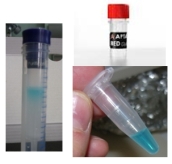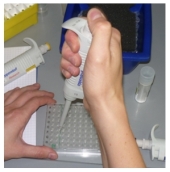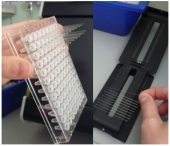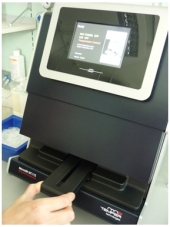
Monolith NT 115 Practical Aspects and Workflow
Before you start - Sample requirements
Protein to be labeled
2-20 µM of Protein in 50-100µl of an appropriate buffer
- chemical labeling requires a purified protein sample
- buffer and significant contaminants must not contain free primary amino groups – (e.g. do not use Tris, use PBS or HEPES instead).
- in principle it is possible to change buffer directly before labeling – desalting columns are optional part of the labeling kit (entails certain risks, like partial loss of protein or denaturation)
- alternatively, there are kits for site directed labelling (his-tag and antibody) available.
Depending on labeling efficiency and stability the labeled sample can be used for hundreds of measurements and can be stored long-term, frozen in aliquots (-80 °C if protein tolerates freezing; addition of cryoprotectant is recommended).
The above indicated protein requirements are based on the usage of the standard Nano Temper protein labelling kit -(Alexa dye, labels amino groups of lysine ). For pre-labeled proteins (GFP,YFP), peptides or DNA/RNA the amount of sample required can be much smaller.
Unlabeled binding partner (titrant)
The purity of the sample is not particularly important.
Initial concentration: ~ 20 x expected Kd - Minimal volume approximately 20 µl, sufficient for one measurement with 16 capillaries (16 dilutions)
Common but not obligatory is using a geometrical dilution series (e.g. 2000, 1000, 500, 250, .... 0,061 nM)
Standard is that the concentration of the fluorescent molecule is kept constant and the concentration of a binding partner is varied.
Equilibrium Method - Which output can be expected?
Microscale thermophoresis (MST) is an equilibrium method. The measurement starts after binding and dissociation equilibrium state is reached, which depending on the type of molecules requires a few seconds up to some minutes.
The technique allows the identification and comparison of binding events including the determination of dissociation constants. Unfortunately, it is not possible to measure binding kinetics in equilibrium to determine kon and koff values.
This drawback is more than offset by the incredibly easy experimental setup of MST compared to SPR.
Workflow
The whole procedure from sample preparation to measurement is simple and straightforward, like the following summary of the steps demonstrates.

Fluorescence labeling with MST standard kit (1h)
Includes changing buffer/desalting (optional) and removal of access dye

pipetting dilution series (5 min)
Fill first well with 20 µl of unlabeled sample (titrant)
give 10 µl of buffer in each following well
dilute geometrically by pipetting 10 µl from previous well into following well

Fill capillaries and put capillaries on tray (5 min)
6-10 µl are required to fill a single capillary
up to 16 capillaries can be used for one dilutions series

Load sample tray
Lock and insert sample tray and start measuring
The measurement cycles can be done unattended

Measure & Evaluate (1h)
The time required for measurement depends on the number of capillaries and the number of cycles (automated repetition with various pre-settings)
The Analysis Software can be distributed and installed locally on your own computer. Thus you can re-analyze data on your own and have a closer look at your results.

